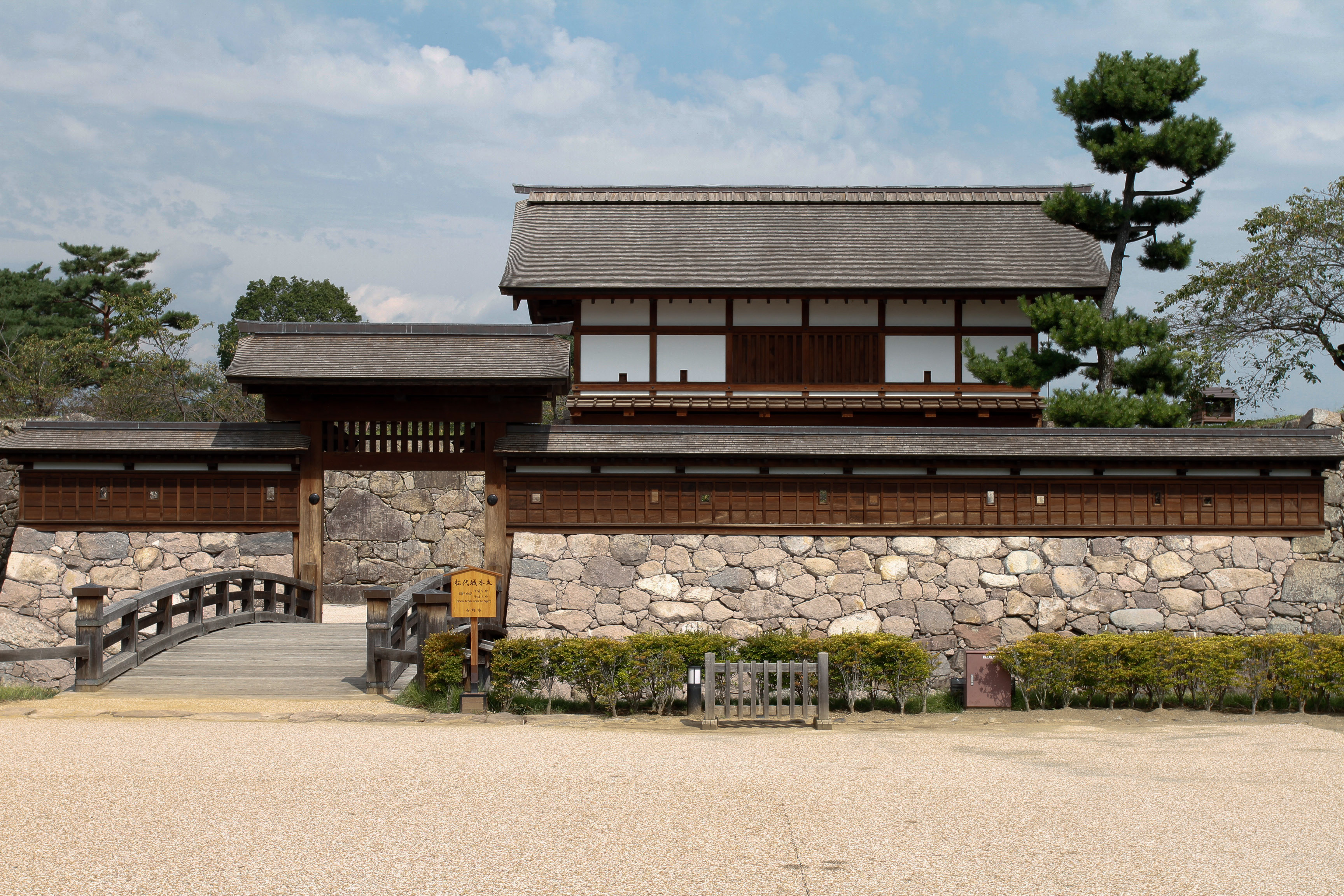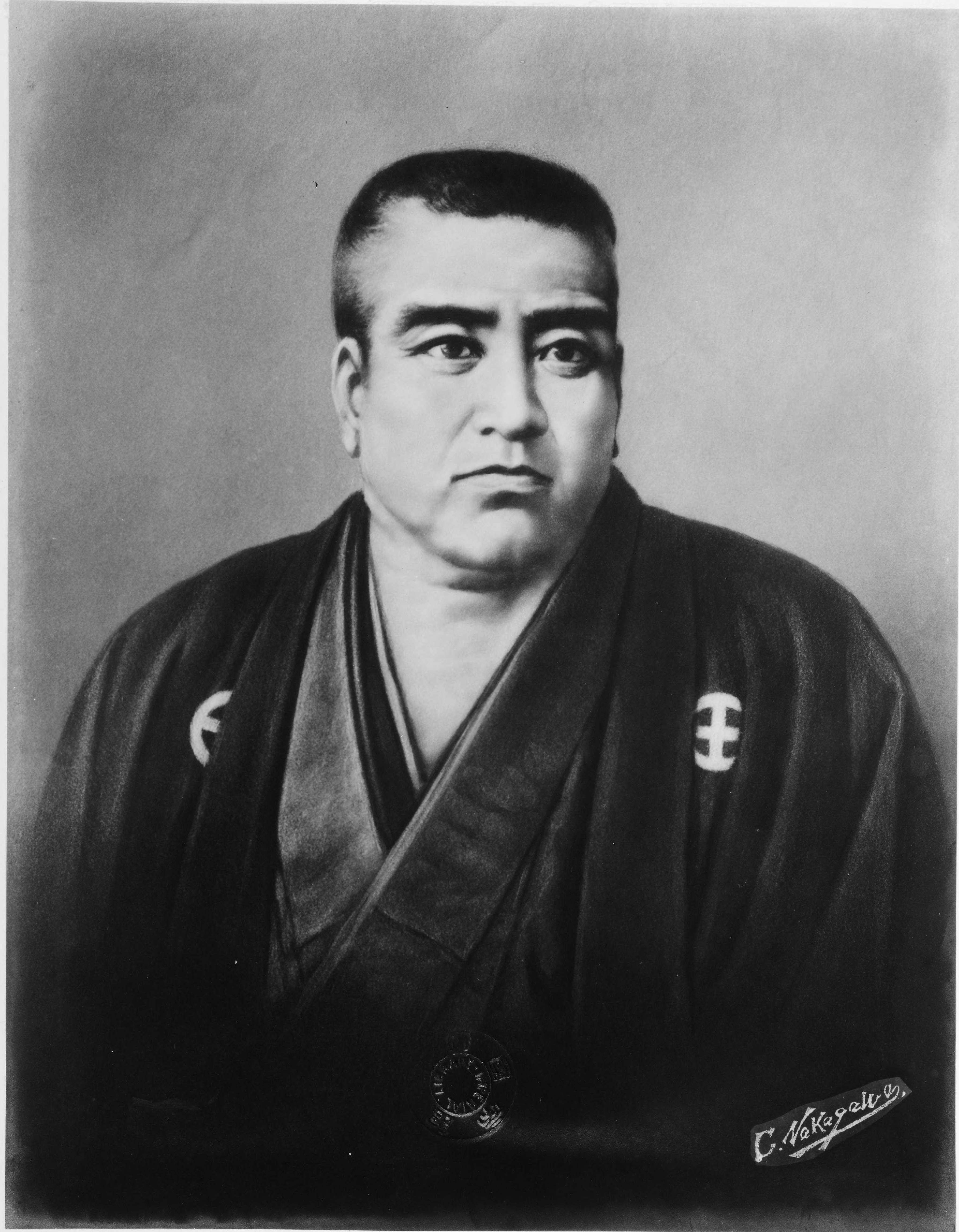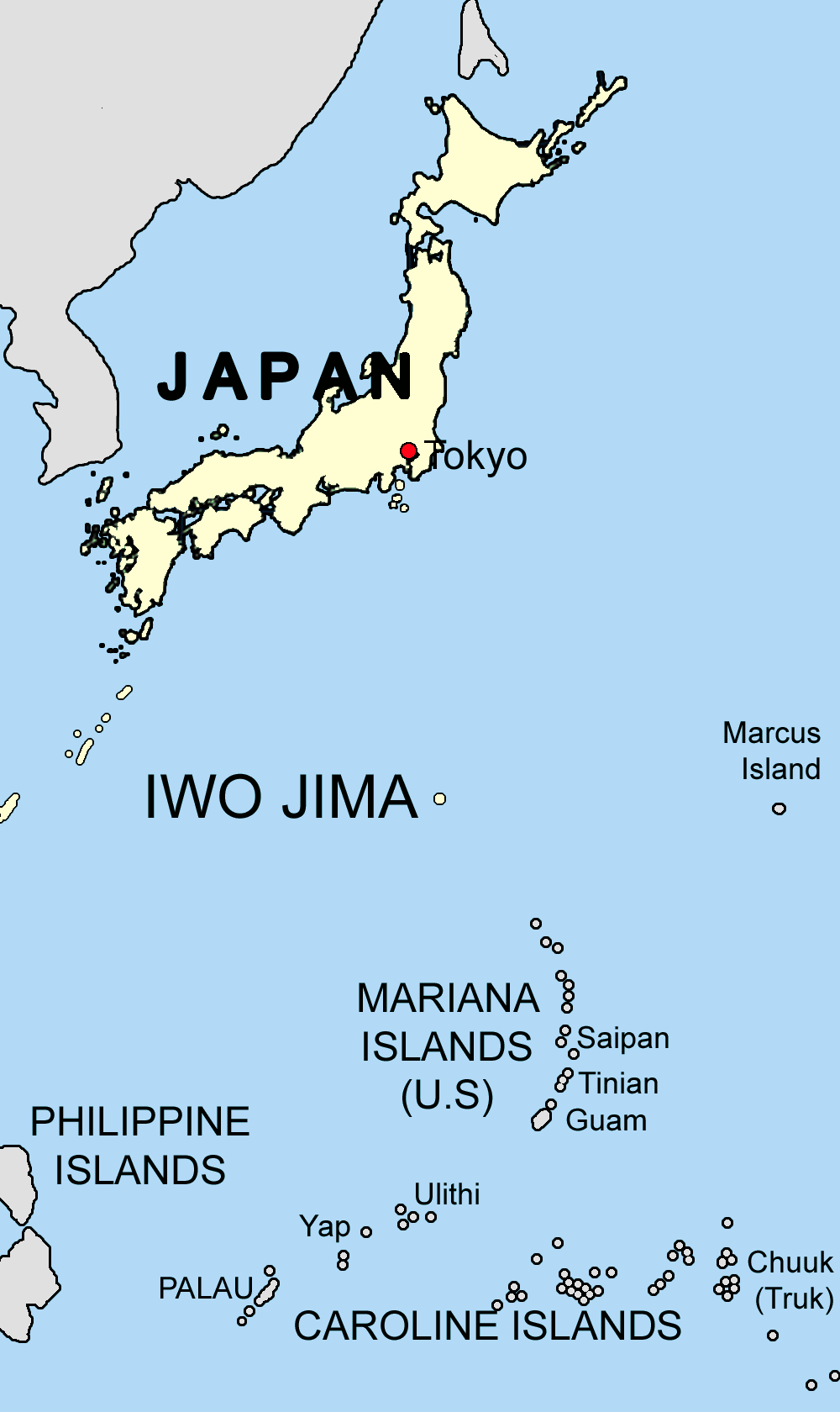|
Tadamichi Kuribayashi
Tadamichi Kuribayashi was a general in the Imperial Japanese Army, diplomat, and commanding officer of the Imperial Japanese Army General Staff. He is best known for having been the commander of the Japanese garrison at the battle of Iwo Jima. Even before the battle, General Kuribayashi insisted upon sharing the hardships of his men. He also refused to permit banzai charges, which he regarded as an unnecessary waste of his men's lives. The United States Marine Corps had expected to capture Iwo Jima in five days, but Kuribayashi and his men held out for 36 days. It is believed that Kuribayashi was killed in action while leading his soldiers in a night-attack on American troops, but his body was never identified by the United States military. U.S. Marine Corps General Holland Smith said of Kuribayashi that "Of all our adversaries in the Pacific, Kuribayashi was the most redoubtable." Early life Kuribayashi was born in Matsushiro, Nagano, to an established samurai family dat ... [...More Info...] [...Related Items...] OR: [Wikipedia] [Google] [Baidu] |
Nagano Prefecture
is a Landlocked country, landlocked Prefectures of Japan, prefecture of Japan located in the Chūbu region of Honshu. Nagano Prefecture has a population of 2,007,682 () and has a geographic area of . Nagano Prefecture borders Niigata Prefecture to the north, Gunma Prefecture to the northeast, Saitama Prefecture to the east, Yamanashi Prefecture to the southeast, Shizuoka Prefecture and Aichi Prefecture to the south, and Gifu Prefecture and Toyama Prefecture to the west. Nagano (city), Nagano is the capital and largest city of Nagano Prefecture, with other major cities including Matsumoto, Nagano, Matsumoto, Ueda, Nagano, Ueda, and Iida, Nagano, Iida. Nagano Prefecture has impressive highland areas of the Japanese Alps, including most of the Hida Mountains, Kiso Mountains, and Akaishi Mountains which extend into the neighbouring prefectures. The area's mountain ranges, natural scenery, and history has gained Nagano Prefecture international recognition as a winter sports tourist de ... [...More Info...] [...Related Items...] OR: [Wikipedia] [Google] [Baidu] |
Imperial Japanese Army
The Imperial Japanese Army (IJA; , ''Dai-Nippon Teikoku Rikugun'', "Army of the Greater Japanese Empire") was the principal ground force of the Empire of Japan from 1871 to 1945. It played a central role in Japan’s rapid modernization during the Meiji period, fought in numerous conflicts including the First Sino-Japanese War, the Russo-Japanese War, World War I, the Second Sino-Japanese War, and World War II, and became a dominant force in Japanese politics. Initially formed from domain armies after the Meiji Restoration, it evolved into a powerful modern military influenced by French and German models. The IJA was responsible for several overseas military campaigns, including the invasion of Manchuria, involvement in the Boxer Rebellion, and fighting across the Asia-Pacific during the Pacific War. Notorious for committing widespread Japanese war crimes, war crimes, the army was dissolved after Japan's surrender in 1945, and its functions were succeeded by the Japan Ground Self-D ... [...More Info...] [...Related Items...] OR: [Wikipedia] [Google] [Baidu] |
Sengoku Period
The was the period in History of Japan, Japanese history in which civil wars and social upheavals took place almost continuously in the 15th and 16th centuries. The Kyōtoku incident (1454), Ōnin War (1467), or (1493) are generally chosen as the period's start date, but there are many competing historiographies for its end date, ranging from 1568, the date of Oda Nobunaga#Ise campaign, Omi campaign, and march to Kyoto, Oda Nobunaga's march on Kyoto, to the suppression of the Shimabara Rebellion in 1638, deep into what was traditionally considered the Edo period. Regardless of the dates chosen, the Sengoku period overlaps substantially with the Muromachi period (1336–1573). This period was characterized by the overthrow of a superior power by a subordinate one. The Ashikaga shogunate, the ''de facto'' central government, declined and the , a local power, seized wider political influence. The people rebelled against the feudal lords in revolts known as . The period saw a break ... [...More Info...] [...Related Items...] OR: [Wikipedia] [Google] [Baidu] |
Samurai
The samurai () were members of the warrior class in Japan. They were originally provincial warriors who came from wealthy landowning families who could afford to train their men to be mounted archers. In the 8th century AD, the imperial court downsized the national army and delegated the security of the countryside to these privately trained warriors. Eventually the samurai clans grew so powerful that they became the ''de facto'' rulers of the country. In the aftermath of the Gempei War (1180-1185), Japan formally passed into military rule with the founding of the first shogunate. The status of samurai became heredity by the mid-eleventh century. By the start of the Edo period, the shogun had disbanded the warrior-monk orders and peasant conscript system, leaving the samurai as the only men in the country permitted to carry weapons at all times. Because the Edo period was a time of peace, many samurai neglected their warrior training and focused on peacetime activities such as a ... [...More Info...] [...Related Items...] OR: [Wikipedia] [Google] [Baidu] |
Nagano Prefecture
is a Landlocked country, landlocked Prefectures of Japan, prefecture of Japan located in the Chūbu region of Honshu. Nagano Prefecture has a population of 2,007,682 () and has a geographic area of . Nagano Prefecture borders Niigata Prefecture to the north, Gunma Prefecture to the northeast, Saitama Prefecture to the east, Yamanashi Prefecture to the southeast, Shizuoka Prefecture and Aichi Prefecture to the south, and Gifu Prefecture and Toyama Prefecture to the west. Nagano (city), Nagano is the capital and largest city of Nagano Prefecture, with other major cities including Matsumoto, Nagano, Matsumoto, Ueda, Nagano, Ueda, and Iida, Nagano, Iida. Nagano Prefecture has impressive highland areas of the Japanese Alps, including most of the Hida Mountains, Kiso Mountains, and Akaishi Mountains which extend into the neighbouring prefectures. The area's mountain ranges, natural scenery, and history has gained Nagano Prefecture international recognition as a winter sports tourist de ... [...More Info...] [...Related Items...] OR: [Wikipedia] [Google] [Baidu] |
Matsushiro, Nagano
Matsushiro () was a historically important town in Hanishina District, Nagano Prefecture, Japan. In 1966, it was incorporated into Nagano City. In general Matsushiro was a thriving town as the center of Matsushiro Domain under the Sanada clan during the Edo period of the 17th to 19th centuries. In the Meiji period of the latter half of the 19th century, there was a thriving silk industry there and the area was known for its Matsushiro ware. During the last days of World War II, Matsushiro Underground Imperial Headquarters was built in the caves of the near-by mountain. In 1966, Matsushiro was incorporated into Nagano City, and remains as Matsushiro-machi, Nagano City. Matsushiro is now famous as a thriving sightseeing area. Transportation About three kilometers south on Prefectural Road 35 ( 長野県道35号長野真田線) from Nagano Station of Hokuriku Shinkansen, Shinetsu Main Line and Shinano Railway Line. About one kilometer south on Prefectural Road 35 from Nagano ... [...More Info...] [...Related Items...] OR: [Wikipedia] [Google] [Baidu] |
Holland Smith
Holland McTyeire "Howlin' Mad" Smith, Order of the Bath, KCB (April 20, 1882 – January 12, 1967) was a General officer, general in the United States Marine Corps during World War II. He is sometimes called the "father" of modern United States, U.S. amphibious warfare. His nickname, "Howlin' Mad" Smith, had been given to him by his troops in the Dominican Republic in 1916. On the eve of World War II, General Smith directed extensive United States Army, Army, United States, Navy, and Marine amphibious training, which was a major factor in successful U.S. landings in both the Atlantic Ocean, Atlantic and Pacific Ocean, Pacific. He subsequently helped prepare U.S. Army and Canadians, Canadian troops for the Kiska and Attu Island, Attu landings, then led the V Amphibious Corps in the assaults on the Gilbert Islands, the Marshall Islands, the island of Saipan, and Tinian in the Marianas. During the Marianas operation, besides the V Amphibious Corps, he commanded all Expeditiona ... [...More Info...] [...Related Items...] OR: [Wikipedia] [Google] [Baidu] |
United States Military
The United States Armed Forces are the Military, military forces of the United States. U.S. United States Code, federal law names six armed forces: the United States Army, Army, United States Marine Corps, Marine Corps, United States Navy, Navy, United States Air Force, Air Force, United States Space Force, Space Force, and the United States Coast Guard, Coast Guard. Since 1949, all of the armed forces, except the Coast Guard, have been permanently part of the United States Department of Defense. They form six of the eight uniformed services of the United States. Each of the different military services is assigned a role and domain. The Army conducts land operations. The Navy and Marine Corps conduct maritime operations, the Marine Corps specializing in amphibious and maritime littoral operations primarily for supporting the Navy. The Air Force conducts air operations. The Space Force conducts space operations. The Coast Guard is unique in that it specializes in maritime opera ... [...More Info...] [...Related Items...] OR: [Wikipedia] [Google] [Baidu] |
Killed In Action
Killed in action (KIA) is a casualty classification generally used by militaries to describe the deaths of their personnel at the hands of enemy or hostile forces at the moment of action. The United States Department of Defense, for example, says that those declared KIA did not need to have fired their weapons, but only to have been killed due to hostile attack. KIAs include those killed by friendly fire during combat, but not from incidents such as accidental vehicle crashes, murder, or other non-hostile events or terrorism. KIA can be applied both to front-line combat troops and naval, air, and support forces. Furthermore, the term died of wounds (DOW) is used to denote personnel who reached a medical treatment facility before dying. The category ''died of wounds received in action'' (''DWRIA'') is also used for combat related casualties which occur after medical evacuation. PKIA means presumed killed in action. This term is used when personnel are lost in battle, initial ... [...More Info...] [...Related Items...] OR: [Wikipedia] [Google] [Baidu] |
United States Marine Corps
The United States Marine Corps (USMC), also referred to as the United States Marines or simply the Marines, is the maritime land force service branch of the United States Department of Defense. It is responsible for conducting expeditionary and amphibious operations through combined arms, implementing its own infantry, artillery, aerial, and special operations forces. The U.S. Marine Corps is one of the six armed forces of the United States and one of the eight uniformed services of the United States. The Marine Corps has been part of the United States Department of the Navy since 30 June 1834 with its sister service, the United States Navy. The USMC operates installations on land and aboard sea-going amphibious warfare ships around the world. Additionally, several of the Marines' tactical aviation squadrons, primarily Marine Fighter Attack squadrons, are also embedded in Navy carrier air wings and operate from the aircraft carriers. The history of the Marine ... [...More Info...] [...Related Items...] OR: [Wikipedia] [Google] [Baidu] |
Banzai Charge
Banzai charge or Banzai attack () is the term that was used by the Allied forces of World War II to refer to Japanese human wave attacks and swarming staged by infantry units. This term came from the Japanese battle cry , and was shortened to banzai, specifically referring to the bayonet charge tactic used by the Imperial Japanese Army during the Pacific War. This tactic was used when the Japanese commanders of infantry battalions foresaw that a battle was about to be lost, as a last ditch effort in thwarting Allied forces. Origin The banzai charge is considered to be one method of , a suicide attack, or suicide before being captured by the enemy such as ''seppuku''. The origin of the term is a classical Chinese phrase in the 7th-century '' Book of Northern Qi'', which states "", "A true man would atherbe the shattered jewel, ashamed to be the intact tile." Among the rules there existed a code of honor that was later used by Japanese military governments. With the revolu ... [...More Info...] [...Related Items...] OR: [Wikipedia] [Google] [Baidu] |
Battle Of Iwo Jima
The was a major battle in which the United States Marine Corps (USMC) and United States Navy (USN) landed on and eventually captured the island of Iwo Jima from the Imperial Japanese Army (IJA) during World War II. The American invasion, designated Operation Detachment, had the goal of capturing the island with its two airfields: South Field (Iwo Jima), South Field and Central Field (Iwo Jima), Central Field. The Japanese Army positions on the island were heavily fortified, with a dense network of bunkers, hidden artillery positions, and of tunnels. The American ground forces were supported by extensive naval artillery, and enjoyed complete air supremacy provided by U.S. Navy and Marine Corps aviators throughout the battle. The five-week battle saw some of the fiercest and bloodiest fighting of the Pacific War. Unique among Pacific War battles involving amphibious island landings, total American casualties exceeded those of the Japanese, with a ratio of three American casual ... [...More Info...] [...Related Items...] OR: [Wikipedia] [Google] [Baidu] |








